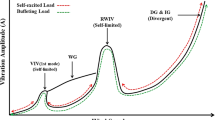Abstract
The development of a steady lift force on a stranded cable, which is yawed with respect to a flow, is a unique characteristic of a cable when compared to a circular cylinder. Comparisons of lift and normal drag coefficients and wake characteristics were made between stranded cable models and the cylinder. These were based upon surface pressure and hot-wire measurements and flow visualization studies conducted in a low speed wind tunnel on rigid cables and cylinders. The models were yawed to four different yaw angles and tested within the Reynolds number range of 5,000 and 50,000. Pressure profiles for the yawed cables indicated that the lift force is directed towards the side where the primary strands are more nearly aligned with the flow. The pressure profiles also indicated that the lift force is generated by asymmetric separation. The small scale irregularities associated with wires within individual strands also appeared to have an effect on the cable's lift and drag characteristics. Results show that cables have significantly different shedding characteristics and near-wake shear layer structure when compared to the circular cylinder. For the flow regime tested, the Strouhal number showed no dependence on Reynolds number nor spanwise position along the cable.
Similar content being viewed by others
Abbreviations
- C dn :
-
normal drag coefficient
- C l :
-
lift coefficient
- C p :
-
pressure coefficient
- D :
-
actual diameter, based on circumscribing circle for the cable
- f v :
-
shedding frequency
- L/D :
-
length to actual diameter ratio
- ppd :
-
“peak-to-peak” distance, unit span
- Re :
-
Reynolds number based on actual diameter
- S :
-
Strouhal number, \(S = \frac{{f_v D}}{V}\)
- V :
-
free stream velocity
- β :
-
cable angle
- θ :
-
azimuthal angle
References
Batill, S. M.; Mueller, T. J. 1980: Visualization of the laminar-turbulent transition in the flow over an airfoil using the smoke-wire technique. AIAA 11th Aerodyn. Test. Conf. AIAA-80-0421-CP
Batill, S. M.; Nelson, R. C; Nebres, J. V. 1988: An experimental investigation of the flow field around yawed, stranded cables. Nav. Coastal Syst. Cent. Contract. Rep. 2201-89-1, Contract No. N00014-83K-0239
Bearman, P. W. 1967: On vortex street wakes. J. Fluid Mech. 28, 625–641
Counihan, J. 1963: Lift and drag measurements on stranded cables. Imp. Coll. Sci. Technol., Aeronaut. Dep. Rep. 117
Fage, A.; Johansen, F. C. 1927: The structure of vortex streets. Aeronaut. Res. Comm. Rep. Memo. 1143, His Majesty's Stationary Office, London
Gerrard, J. H. 1966: The mechanics of the formation region of vortices behind bluff bodies. J. Fluid Mech. 25, 401–413
Horton, K.; Ferrer, C; Watson, K.; Charvoz, D. 1987: Measurement of the hydrodynamic force and strum characteristics of stranded cables. Nav. Coastal Syst. Cent. Tech. Memo. 471–487
Navy, unknown author, 1949: Wind-tunnel tests of mine sweeper cables. David W. Taylor Model Basin Rep. R-312, Dep. Navy, Aero Rep. 705
Nebres, J. 1989: Flow around yawed stranded cables. M. S. Thesis, University of Notre Dame, Dept. of Aerospace and Mechanical Engineering, USA
Ramberg, S. 1983: The influence of yaw angle upon the vortex wakes of stationary and vibrating cylinders. Nav. Res. Lab. Memo. Rep. 3822; J. Fluid Mech., 128, 81–107
Richards, D. 1963: Aerodynamic properties of the Severn crossing conductor. Proc. Natl. Phys. Lab. Symp. 16, Teddington, 1963
Roshko, A. 1955: On the wake and drag of bluff bodies. J. Aeronaut. Sci. 22, 124–132
Schultz, M. P. 1962: Wind-tunnel determination of the aerodynamic characteristics of several twisted wire ropes. David W. Taylor Model Basin Aerodyn. Lab. Rep. 1645, Aero Report 1028
Smith, R.; Moon, W.; Kao, T. 1972: Experiments on flow about a yawed circular cylinder. Trans. ASME, J. Basic Eng., 44, 771–776
Votaw, C. W.; Griffin, O. M. 1971: Vortex shedding from smooth cylinders and stranded cables. Trans. ASME, J. Basic Eng. 93, 457–460
West, G. S.; Apelt, C. J. 1982: The effects of tunnel blockage and aspect ratio on the mean flow past a circular cylinder with Reynolds numbers between 104 and 105. J. Fluid Mech. 114, 361–377
Author information
Authors and Affiliations
Rights and permissions
About this article
Cite this article
Nebres, J., Batill, S. & Nelson, R. Flow about yawed, stranded cables. Experiments in Fluids 14, 49–58 (1993). https://doi.org/10.1007/BF00196987
Received:
Issue Date:
DOI: https://doi.org/10.1007/BF00196987



